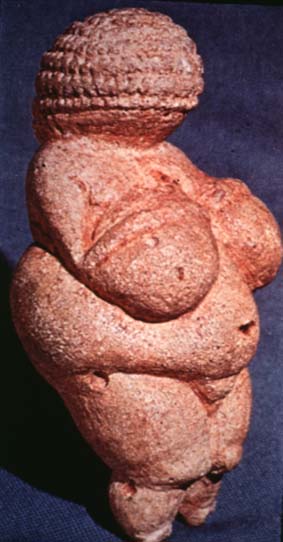
Portfolio: Venus de Willendorf

"Venus" of Willendorf
c. 24,000-22,000 BCE
Oolitic limestone
4 3/8 inches (11.1 cm) high
(Naturhistorisches Museum, Vienna)
------------------------------------
Women in Prehistory
The "Venus" of Willendorf
Christopher L. C. E. Witcombe
The most famous early image of a human, a woman, is the
so-called "Venus" of Willendorf, found in 1908 by the archaeologist
Josef Szombathy [see BIBLIOGRAPHY] in an Aurignacian loess deposit
near the town of Willendorf in Austria and now in the Naturhistorisches
Museum, Vienna.
The statuette was carved from a particular type of oolitic
limestone not found in the region and so must have been brought
to the area from another location. It may well be the case that
the carving, which was presumably done with flint tools, was not
done locally.
When first discovered the "Venus" of Willendorf was thought
to date to approximately 15,000 to 10,000 BCE, or more or less
to the same period as the cave paintings at Lascaux in France.
In the 1970s the date was revised back to 25,000-20,000
BCE, and then in the 1980s it was revised again to c. 30,000-25,000
BCE A study of the stratigraphic sequence of the nine superimposed
archaeological layers comprising the Willendorf deposit published
in 1990, which offers a key for the relative and absolute Carbon
14 chronology of the Central European Upper Palaeolithic, however,
now indicates a date for the "Venus" of Willendorf of around 24,000-22,000
BCE (26-24,000 B.P.).
Her great age and exaggerated female forms have established the
"Venus" of Willendorf as an icon of prehistoric art. As the discipline
of art history underwent a paradigm shift during the 1960s away
from discussing art objects that were characteristic of an age
to selecting art objects that represented the highest artistic
accomplishments of the age, no matter how unique and extraordinary,
the "Venus" of Willendorf quickly achieved a singular status.
Although she was already being included in books devoted
to Stone Age art published in the 1920s, it is not until the 1960s
that the statuette begins to appear in the introductory art history
books where she quickly displaced other previously used examples
of Palaeolithic art. Being both female and nude, she fitted perfectly
into the patriarchal construction of the history of art that has
tended to emphasize the more derogatory depictions of women in
art through the ages.
As the earliest known representation, she became the "first"
woman, acquiring an Ur-Eve identity that focused suitably, from
a patriarchal point of view, on the fascinating yet grotesque
reality of the female body and its bulging vegetable nature; an
impersonal composition of sexually-charged swollen shapes; an
embodiment of overflowing fertility, of mindless fecundity, of
eternal sex, the woman from which all women descend.